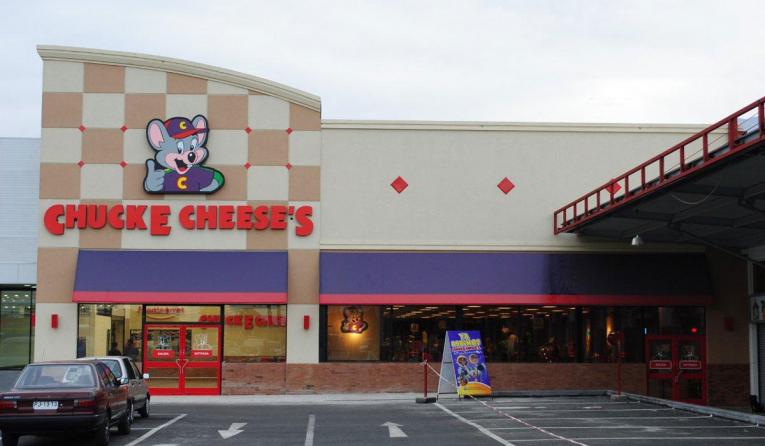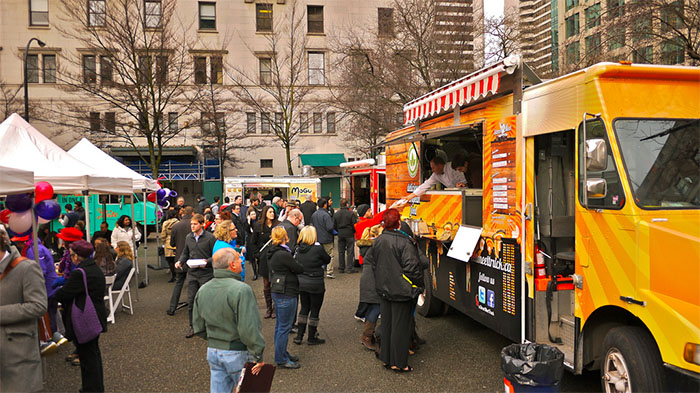Chuck E. Cheese, originally known as Chuck E. Cheese’s Pizza Time Theatre, is a family entertainment chain that features arcade games, amusement rides, and animatronic displays in addition to serving pizza and other food items. It’s the first-ever family restaurant to integrate food with animated entertainment and indoor arcade games. The company was established in 1977 by Nolan Bushnell, one of the founding fathers of the video game industry. There’s a fantastic Jeopardy fact for the readers out there.
How much will it cost to open a Chuck E. Cheese restaurant? You’ll need a minimum liquid capital of $800,000 and a net-worth $1 million to qualify for the financial requirements. Due to some of the overhead including a large required lease space and entertainment equipment, the cost to get started is higher than other pizza franchises.
If you want to know if you can still start a Chuck E. Cheese, I break down the prospects of the franchise. It’s no secret the franchise has had a bumpy ride the last two years. Click here to take our 7-minute franchise business quiz to find out if Chuck E. Cheese is a good fit for your goals and budget. Let’s do this.
Page Contents
- Financial Requirements and Fees
- Average Sales / Revenue Per Year
- Chuck E. Cheese Franchise Facts
- How Much Profit Does A Franchisee Of Chuck E. Cheese Make Per Year?
- Advantages of Franchising Chuck E. Cheese
- Fun and Unique Experience
- Menu Offerings
- Family-Friendly Environment
- Challenges of Franchising Chuck E. Cheese
- Confusing Brand Name
- Bankruptcy History
- Competition
- Not Known for Delivery
- Is The Chuck E. Cheese Franchise Right For You?
- What is an alternative Chuck E. Cheese franchise?
Financial Requirements and Fees
The family entertainment chain recently filed for bankruptcy, so the chance isn’t good that you can still own a Chuck E. Cheese franchise. As it navigates the most challenging era in its history, CEC Entertainment’s CEO says that the food-and-games business might focus more on technology and at-home experiences.
But if, by some miracle, the pandemic ends and everything goes back to normal, all the available financial details that you need to know about this franchise opportunity are available here.
Note: Success or failure of this concept could be highly dependable on where you operate. Operate in a state with recurring lock-downs? That’s not great news. You need to be confident you can remain open prior to investing in this concept.
| Fees or Expenses | Financial Amount |
| Liquid Capital | $800,000 |
| Net Worth | $1,000,000 |
| Total Investment | $1.17 million to $1.83 million |
| Franchise Fee | $800,000 |
Did Chuck E. Cheese File for Bankruptcy? With $1–2 billion estimated debt, all CEC properties are threatened to close if the company’s bankruptcy refinancing failed. The company filed a voluntary bankruptcy petition under Chapter 11 of the Bankruptcy Code on June 25, 2020. Chapter 11 is one of the most common divisions that companies adhere to when they are unable to pay their creditors but want to restructure and continue operating.
Good news is that Chuck E. Cheese has been able to bounce back quickly. It was announced on December 30, 2020, the company completed its financial restructuring and emerged from Chapter 11 protection. Under new ownership and a new leadership board, the company emerged came out of bankruptcy with $705 million in debt obligations paid off.
Average Sales / Revenue Per Year
The revenue of Chuck E. Cheese in 2019 was approximately $912.87 million, slightly higher compared to $896.07 million revenue in 2018. Moreover, the average annual sales per Chuck E. Cheese’s location worldwide was approximately $1.62 million in 2019 and $1.59 million in 2018. The company had over 15,000 employees and had more than 600 locations around the world.
The pandemic placed a significant financial burden on the company, prompting the parent company to declare bankruptcy. Although the restaurant chain was already struggling prior, the pandemic’s prolonged closures were the final straw.
With $1–2 billion in outstanding debt, it’s probable that all CEC properties will be forced to close if the corporation is unable to achieve bankruptcy refinancing. CEC Entertainment sought $200 million in loans to fund a restructure under bankruptcy protection. They also filed a voluntary bankruptcy filing under Chapter 11 of the Bankruptcy Code on June 25, 2020.
You Might Also Like: How Much Does it Cost to Open a Domino’s Franchise?
The Chapter 11, From Bankruptcy Law in the is one of the most common legal actions companies use when they’re unable to pay their creditors but want to restructure and continue operating.
Chuck E. Cheese Franchise Facts
| Total Units: | 612 (Corporate and franchise stores) |
| Incorporated Name: | Chuck E. Cheese |
| Franchising Since: | 1979 |
| Industry: | Family and Entertainment Restaurant |
| Subsector: | Fast Food restaurant, Pizza Chain, Arcade Games |
Chuck E. Cheese’s Pizza Time Theatre, the original name of the chain, was founded by Atari co-founder Nolan Bushnell who wanted to expand the purview of video game arcades beyond more adult settings like billiard halls to a child and family-friendly location.
Bushnell’s background in the amusement park business, along with his admiration for the Walt Disney Company, influenced the development of the Pizza Time Theatre concept. The first branch opened in 1977 in San Jose, California, and was described as the first family restaurant to combine food, inexpensive animated entertainment, and an indoor arcade.
In 1978, Bushnell bought the Pizza Time Theatre concept from Atari’s then-parent company, Warner Communications. “It was my pet project… I chose pizza because of the wait time and the build schedule: very few components and not too many ways to screw it up,” said Bushnell upon his decision to establish a pizza restaurant.
After learning from animatronics employees that the costume he purchased was a rodent rather than a coyote, Bushnell says he considered changing the name of the restaurant from “Coyote Pizza” to “Rick Rat’s Pizza.” Marketing people didn’t like it and suggested “Chuck E. Cheese” instead and it was the final name that selected.
Not Sure What Franchise to Start? Take Our 7-Minute Franchise Business Quiz!
The global pandemic has been financially devastating to the parent company and with $1-2 billion in outstanding debt, all CEC properties were threatened to close if the company is unable to obtain bankruptcy funding. CEC Entertainment sought $200 million in financing to fund a bankruptcy-protected restructuring. This was a tough time period for live entertainment with large groups of people.
But even so, after filing for Chapter 11 bankruptcy in June 2020 and submitting a plan of reorganization that was approved by the United States Bankruptcy Court on December 15, 2020, Chuck E. Cheese parent company CEC Entertainment announced on December 30 that the company had completed its financial restructuring and had emerged from Chapter 11 protection.
How Much Profit Does A Franchisee Of Chuck E. Cheese Make Per Year?
The family-style restaurant chain Chuck E. Cheese’s made a net income (loss) of approximately -28.92 million U.S. dollars in 2019 and -20.46 million U.S dollars in 2018. In June 2020, due to the company’s $1 billion debt load and the COVID-19 pandemic forcing closures of all its locations, the parent company, CEC Entertainment, declared Chapter 11 bankruptcy.
The pandemic caused many changes to the “eater-tainment” brand and its parent company CEC Entertainment. Chuck E. Cheese became the first major chain to file bankruptcy during the pandemic crisis, the company CEO David McKillips said in an interview. “Everything we’re doing, we want to have in-store, at home, and online,” McKillips said.
Birthday parties historically accounted for 15% of Chuck E. Cheese’s sales. The number of birthday parties that can be held at each location per day is severely limited due to capacity restrictions, so they pivoted to deliver birthdays at home instead.

Chuck E Cheese’s Pepperoni And Beef Pizza.
Advantages of Franchising Chuck E. Cheese
Owning a Chuck E. Cheese franchise, like owning any other type of business, has advantages and disadvantages. I’ve highlighted the benefits right here to help you make a better-informed decision.
Fun and Unique Experience
Chuck E. Cheese offers a fun and unique experience to its consumers by providing food combined with entertainment. Games and entertainment shows are not only fun attractions, but they can also serve as promotional advantages and enable staff and guests to bond and help occasional customers become regulars.
Combining food with entertainment in one venue is often referred to as an “eater-tainment,” and this is actually a growing trend nowadays. CBRE Group, a real estate firm located in Los Angeles, predicted that such concepts would continue to open.
“As eatertainment operators downsize to smaller, tech-driven formats, they will infill urban locations and be a catalyst for the revitalization of main urban streets in select markets,” the CBRE report says. “Consumer demand is rising for more experience-rich recreation and dining options in retail properties. Its incorporation in malls and non-mall settings has grown by 44.7 percent and 68.5 percent, respectively, since 2010.”
Menu Offerings
Although serving pizza is what the company is famous for and has been the main focus of the dining portion of the business, the restaurant offers wings, kid-sized chicken nuggets, mozzarella sticks, and pretzel bites, as well as sweets such as churros, cakes, and Dippin’ Dots. They even offer a salad bar in some locations, believe it or not.
Related Reading: How Much Does it Cost to Open a Little Caesars Franchise?
A direct perk of having a wide menu offering is that you can serve different taste buds within the main target audience (pizza-lovers) and even aim for a broader audience (vegans). Hence, your target audience will be wider. Another perk is that your customers would love to come back for more, especially when there are other menu items they have not tried yet. Curiosity will keep people coming back because you serve a wide selection of foods that they’d love to try.
Family-Friendly Environment
According to the National Restaurant Association, approximately six out of ten consumers say they consider a restaurant’s family or child-friendliness when choosing where to dine. “Parties with children under 12 account for $17.7 billion in annual restaurant spending,” says Ian Davidson, brand insight senior manager for C3, a marketing agency specializing in children and family promotions.
Kids are irresistibly drawn to playing entertaining games. Offering fun and memorable experiences will encourage children to ask their parents to revisit. When I was a kid growing up, I can attest that the video games were my favorite part of visiting this restaurant. I could care less about the pizza.
Challenges of Franchising Chuck E. Cheese

Frozen classic cheese pizza of Chuck E Cheese.
There are disadvantages and acknowledged dangers to owning a Chuck E. Cheese franchise, in addition to the advantages. Here I evaluate the challenges of this business.
Confusing Brand Name
Chuck E. Cheese has undergone many changes with their name. Originally, the company was named “Chuck E. Cheese’s Pizza Time Theatre” in 1977. After filing bankruptcy in 1984, Brock Hotel Corporation, the parent company of a competitor, ShowBiz Pizza Place, purchased the franchise in 1985.
The merger formed a new parent company, ShowBiz Pizza Time, Inc., and it began integrating the two names in 1990, renaming every site Chuck E. Cheese’s Pizza. In 1994, it was shortened to Chuck E. Cheese’s, and in 2019, it was shortened to Chuck E. Cheese.
Related Reading: How Much Will It Cost to Open a Pizza Hut?
The brand name can make the difference between a successful brand and one that fails. If it repeatedly changes over time, there will be a tendency that consumers will get confused over your brand.
Bankruptcy History
The restaurant chain had already been struggling even before the Covid-19 pandemic. In 1983, the video game industry experienced a crash. Consoles and arcades took a beating as more people moved to computer games. Arcades around the country have closed as video game sales have plummeted by 97 percent.
Clearly, it was not the best moment to open an arcade-themed restaurant. Chuck E. Cheese’s losses were estimated to be $15 million that year, and just a year later, the company declared bankruptcy. In addition to that, just recently, they filed a voluntary petition under Chapter 11 of the Bankruptcy Code in the United States Bankruptcy Court for the Southern District of Texas.
Luckily, the company was able to complete its financial restructuring and had emerged from Chapter 11 protection. Under new ownership and a new leadership board, the company emerged from bankruptcy with $705 million in debt obligations paid off.
Competition
Chuck E. Cheese has a large number of competitors, especially since many other well-known fast-food businesses offer pizza as a specialty. Aside from that, many additional “eatertainment” businesses are popping up in the market because of the growing trend and as more consumers prefer experiences over products.
Not Known for Delivery
The company is making strides to become more delivery friendly. But historically this isn’t how the company made money. As a casual consumer, I never viewed the quality of pizza as the reason you dined at this restaurant. You went for the fun and games. You didn’t go because it was your favorite pizza. If the company hopes to pivot, they’ll need to get the word out about their delivery options and improve their pizza. Domino’s is one such chain that was able to pivot and improve their crust and pizza over the past decade.
Is The Chuck E. Cheese Franchise Right For You?
To know if Chuck E. Cheese is the right franchise for you, you must weigh the advantages and disadvantages. You’ve also got to consider the uncertainty of the concept in the current environment. If you believe the good outweighs the bad then you’re good to go. Another factor to consider is having the needed resources, skill set, and passion for this type of business.
Success in this franchise or any other type of business, necessitates passion. As a franchisee, you will undoubtedly confront challenges. Passion is the fuel that keeps you moving when you might otherwise be static or give up. Entrepreneurs that are passionate about their business are more likely to overcome hurdles and move forward.
What is an alternative Chuck E. Cheese franchise?
There are many other good Chuck E. Cheese alternatives on the market that are performing well. Dave & Buster’s and John’s Incredible Pizza are two of these options. These businesses are also “entertainment” restaurants that combine dining with entertainment.




